Remains of Viking settlement discovered on Scottish island
and live on Freeview channel 276
The finds were made on a hillock overlooking the sea at an undisclosed location on the island with the site now considered to be the most important one of its kind on Tiree.
A piece of bone pin – thought to have been used to fasten a cloak – was among items found at the site with a Viking-era loom weight and boat rivet also discovered.
Advertisement
Hide AdAdvertisement
Hide AdA piece of discarded boar tusk and remains of burnt alder, birch, hazel and heather were also retrieved.


Radiocarbon dating has placed the loom weight to around 790 and 990AD, a period when Vikings are known to have been living on the island.
Dr John Holliday, a retired GP and archaeology enthusiast who has lived on the island for 30 years, discovered the remains of the Viking site while out walking.
The exact location of the site is being kept a closely guarded secret for the time being with senior archaeologists now hoping to carry out excavations there in due course.
Advertisement
Hide AdAdvertisement
Hide AdDr Holliday said: “To find a Norse site on Tiree is very exciting to me and it is a great responsibility.
“There aren’t very many of these sites in the Hebrides. It is in a very sensitive part of the island close to the beach and we now have a number of senior archaeologists working to take this forward.”
Dr Holliday said it was now believed that Tiree, which is well-known for its fertile land, was specifically pinpointed by the Norse settlers.
Dr Holliday said: “There is a new understanding that the islands in the south Hebrides were some of the first Viking acquisitions – they were not an afterthought.”
Advertisement
Hide AdAdvertisement
Hide AdHowever, there is a still a mystery surrounding the origins of the bone pin found at the site.
Archaeologist Dr Colleen Batey, of Glasgow University, said the item could not be assigned to the Viking era, with several experts of the same view.
“It is unique and essentially specifically undated,” she added.
On Tiree, it is known that a Gaelic-speaking native population survived alongside the new settlers from the ninth century.
Advertisement
Hide AdAdvertisement
Hide AdAccording to accounts, a new line of half Gael, half Norse mercenary warriors – the Gall-Gaedhil – developed in the Hebrides and many leaders mentioned in this period have one parent from either group.
Viking discoveries have been rare on Tiree with hopes that the latest finds will draw new attention to the island’s archaeology.
Dr Holliday added: “Tiree has had very little archaeology time spent on it compared to other places but I think that is starting to pick up now. This is definitely the most important site so far.”
A brass oval brooch, thought to have been from a female Viking-era grave, was found on the island during the late 19th Century.
Advertisement
Hide AdAdvertisement
Hide AdA further legacy of the Norse settlers is the dozens of place names they left behind.
Research has shown that more than 180 place names with northern influence still exist. The name of Tiree’s main township, Scarinish, is a combination of Norse words which mean cormorant and headland.
The Viking name for the island was Tyrvist, from which the modern Gaelic name for an islander, Tirisdeach, is thought to be derived.
Dr Holliday added: “It is fair to say that Tiree was a Norse speaking country for 400 years. Tiree was a such a fertile island that it was known as the Land of Barley.
“You find Norwegian farm names in every nook and cranny. They went everywhere, which is not surprising as it was so fertile.”